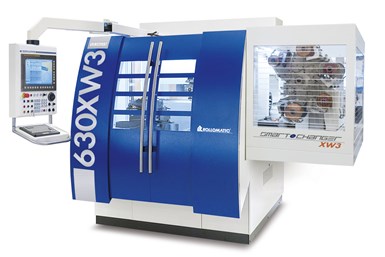Rollomatic GrindSmart Offers Flexibility for Tool Grinding
Rollomatic’s GrindSmart 630XW six-axis tool grinder allows manufacturers to grind a variety of indexable inserts and round-shank tools on a single machine.
Share






Rollomatic’s GrindSmart 630XW machine is designed to offer more flexibility in grinding indexable inserts and other stationary cutting tools than conventional, single-purpose grinders. With its six fully interpolated CNC axes, a six‐station wheel changer and wheel inclination ranging to 45 degrees, the machine supports simple adaptation for short and long runs of individual insert designs. Its design allows full interchangeability between inserts and round tools, according to the company.
The clamping systems are designed to emulate the way inserts fit into their tool holders, increasing concentricity and accuracy. The clamping design supports indexable, non‐indexable and replaceable inserts; threading and form inserts; dog‐bone and grooving inserts; drilling, milling and ballnose tip inserts; and other non‐round tools. An electronic touch probe determines the exact location of the insert blank after clamping, allowing the software to grind the tool geometry according to the virtual centerline of the insert blank and achieve a run-out of 0.0001", according to Rollomatic.
The company says the machine’s six- or 16-station wheel and nozzle changer offers flexibility for grinding a variety of inserts and other stationary cutting tools while maintaining the ability to change to round‐shank tools within minutes.
Additional features include an IC diameter range from 3.9 to 25.4 mm with automatic handling, linear motion control on CNC axes, desktop tool design software with 3D tool simulation and 3D machine animation with collision warning, chipbreaker grinding on the rake face, edge preparation grinding on the cutting edge, and a pick-and-place robot that protects inserts from damage after grinding. Optional features include a part flipper, an in-process rotary dressing and an automatic sticking device.
Related Content
-
How to Determine the Currently Active Work Offset Number
Determining the currently active work offset number is practical when the program zero point is changing between workpieces in a production run.
-
6 Machine Shop Essentials to Stay Competitive
If you want to streamline production and be competitive in the industry, you will need far more than a standard three-axis CNC mill or two-axis CNC lathe and a few measuring tools.
-
Lean Approach to Automated Machine Tending Delivers Quicker Paths to Success
Almost any shop can automate at least some of its production, even in low-volume, high-mix applications. The key to getting started is finding the simplest solutions that fit your requirements. It helps to work with an automation partner that understands your needs.
















.jpg;maxWidth=300;quality=90)




